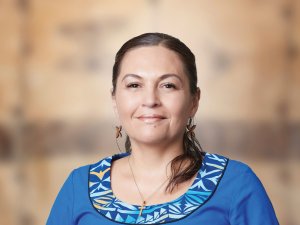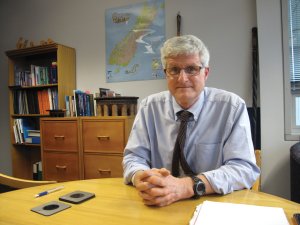Respiratory physician Lutz Beckert considers chronic obstructive pulmonary disease management, including the prevention of COPD, the importance of smoking cessation and pulmonary rehabilitation, and the lifesaving potential of addressing treatable traits. He also discusses the logic of inhaler therapy, moving from single therapy to dual and triple therapy when indicated, as well as other aspects of management
Celebrating wins but wanting more: One small step towards a Māori health workforce with critical mass
Celebrating wins but wanting more: One small step towards a Māori health workforce with critical mass

Māori health scholarships are getting a sorely needed new lease on life with a boost to funding, writes Gabrielle Baker
The health reforms have had some bad press lately. Some of this is inevitable in an election year and is hardly surprising when opposition parties have promised to scrap Te Aka Whai Ora.
And some of the bad press is entirely justified, when the aims of the “transformation” aren’t matched with tangible and visible changes to the day-to-day workings of the health system, or the changes are simply too slow.
However, good news arrived last month in the form of the long-awaited makeover of the Hauora Māori Scholarships. These have been amazing but have barely changed since the 1990s. Te Aka Whai Ora is giving them a new lease on life as Te Pitomata Grants.
Increasing the Māori health workforce is generally accepted as a good thing. Reports have been recommending an increase since forever, or at least since the 1980s.
For example, the report from Māori health planning workshop Hui Whakaoranga in 1984 states that one of the priorities must be to address “the lack of Māori personnel in the health services”.
Māori workforce has also been a priority of governments’ Māori health strategy for over 20 years. The original one, He Korowai Oranga in 2002, stated: “Māori workforce development needs acceleration and greater co-ordination.”
Building the number of Māori in the health workforce is intrinsically valuable and part of creating a health system that can guarantee Māori communities have options to access kaupapa Māori health services.
If the health system cannot recruit and retain Māori health professionals, then there is something wrong with the health system. We could also see building the number of Māori health professionals as a necessity, thanks to the relentless pressure on our existing workforce.
The Government has a range of tools it can use to build the Māori health workforce, from investing in education that works for Māori, to getting Māori students interested in health careers, and creating attractive and fulfilling career pathways for Māori already in the health workforce. But few of these actions are as easy to describe and implement as running a scholarship programme, which is what the Government landed on in the 1990s when it created the Hauora Māori Scholarships.
These scholarships were designed to provide financial assistance to Māori students who commit to working in Māori health, and who are undertaking study towards a New Zealand Qualifications Authority-accredited course or some other healthcare worker training.
The Hauora Māori Scholarships, though they helped thousands of students, were becoming tired even in 2007
The Hauora Māori Scholarships, though they helped thousands of students, were becoming tired even in 2007, when they were first evaluated (by the Centre for Māori Health Research at AUT and hauora.com).
That evaluation observed the scholarships could be improved by “increasing the level of scholarship funding available to individual recipients to better reflect growing costs of tuition fees and other study-related expenses”.
The total value of the Hauora Māori Scholarships increased markedly between 2007 and 2008 (from a little over $1 million per year to $1.25 million per year), but across its existence the scheme has, as a whole, barely kept up with inflation.
And for most students, even having their scholarship amount keep up with inflation was a pipe dream. For example, the amount a physiotherapy student received in 2002 was $1500, which by 2019 was $1700, meaning the purchasing power of many individual scholarships decreased over time.
A 2019 review of the Hauora Māori Scholarships by AwhiMai Consultancy also highlighted, however, that there were inequitable exceptions to the amount paid to individual students. While medicine accounted for 21 per cent of all scholarships between 2008 and 2019, medical students received nearly 40 per cent of the total amount available. Nursing represented 28 per cent of all scholarships but received only about 20 per cent of the total funding.
You might argue this difference is a recognition of higher course costs or living expenses for medical students, but this would be conjecture as the Ministry of Health didn’t appear to base the funding levels on anything as objective as that.
The AwhiMai review recommended that the Hauora Māori Scholarships be improved and specifically that they become better at targeting funding to addressing financial barriers for students.
This recommendation appears to have been taken on board to some degree with the new, improved, updated and refreshed Te Pitomata Grants, which replace the Hauora Māori Scholarships.
It is difficult to tell from the information publicly available, but the key changes seem to be the simplified categories for funding.
Instead of 11 different categories, there are five. The funding has increased, so that the grant fund is now worth $3.27 million a year (up from just under $1.5 million).
The same grant amount is available for all scholarships. Regardless of what career students are training for, all successful applicants will receive $4500 a year. That’s a slight improvement for medical and dental students and a substantial one for others, such as those nursing, midwifery and physiotherapy students, who were previously eligible for $1700 a year.
There is still room for improvement administratively: the AwhiMai review recommended changes to the application forms online. At press deadline late last month, Te Pitomata application forms were still not accessible to anyone using their smartphone. However, there has been a marked and tangible improvement.
The bigger, better scholarships represent a small but important step towards making real some of the promises made in establishing a Māori health authority. Yay.
Gabrielle Baker (Ngāpuhi, Ngāti Kuri) is an independent health policy consultant
We're publishing this article as a FREE READ so it is FREE to read and EASY to share more widely. Please support us and our journalism – subscribe here
One of the benefits of subscribing is you will also be able to share your thoughts about what you read with other in our Comment Stream. You can also take notes on what you read with Capture



![Medical Stress illustration [Image: Molotovcoketail on iStock]](/sites/default/files/styles/cropped_image_4_3/public/2023-04/Medical%20Stress%20illustration%20CR%20molotovcoketail%20on%20iStock.png?itok=ENIjby25)




![Barbara Fountain, editor of New Zealand Doctor Rata Aotearoa, and Paul Hutchison, GP and senior medical clinician at Tāmaki Health [Image: Simon Maude]](/sites/default/files/styles/thumbnail_cropped_100/public/2025-03/Barbara%20Fountain%2C%20editor%20of%20New%20Zealand%20Doctor%20Rata%20Aotearoa%2C%20and%20Paul%20Hutchison%2C%20GP%20and%20senior%20medical%20clinician%20at%20T%C4%81maki%20Health%20CR%20Simon%20Maude.jpg?itok=-HbQ1EYA)
![Lori Peters, NP and advanced health improvement practitioner at Mahitahi Hauora, and Jasper Nacilla, NP at The Terrace Medical Centre in Wellington [Image: Simon Maude]](/sites/default/files/styles/thumbnail_cropped_100/public/2025-03/2.%20Lori%20Peters%2C%20NP%20and%20advanced%20HIP%20at%20Mahitahi%20Hauora%2C%20and%20Jasper%20Nacilla%2C%20NP%20at%20The%20Terrace%20Medical%20Centre%20in%20Wellington%20CR%20Simon%20Maude.jpg?itok=sUfbsSF1)
![Ministry of Social Development health and disability coordinator Liz Williams, regional health advisors Mary Mojel and Larah Takarangi, and health and disability coordinators Rebecca Staunton and Myint Than Htut [Image: Simon Maude]](/sites/default/files/styles/thumbnail_cropped_100/public/2025-03/3.%20Ministry%20of%20Social%20Development%27s%20Liz%20Williams%2C%20Mary%20Mojel%2C%20Larah%20Takarangi%2C%20Rebecca%20Staunton%20and%20Myint%20Than%20Htut%20CR%20Simon%20Maude.jpg?itok=9ceOujzC)
![Locum GP Helen Fisher, with Te Kuiti Medical Centre NP Bridget Woodney [Image: Simon Maude]](/sites/default/files/styles/thumbnail_cropped_100/public/2025-03/4.%20Locum%20GP%20Helen%20Fisher%2C%20with%20Te%20Kuiti%20Medical%20Centre%20NP%20Bridget%20Woodney%20CR%20Simon%20Maude.jpg?itok=TJeODetm)
![Ruby Faulkner, GPEP2, with David Small, GPEP3 from The Doctors Greenmeadows in Napier [Image: Simon Maude]](/sites/default/files/styles/thumbnail_cropped_100/public/2025-03/5.%20Ruby%20Faulkner%2C%20GPEP2%2C%20with%20David%20Small%2C%20GPEP3%20from%20The%20Doctors%20Greenmeadows%20in%20Napier%20CR%20Simon%20Maude.jpg?itok=B0u4wsIs)
![Rochelle Langton and Libby Thomas, marketing advisors at the Medical Protection Society [Image: Simon Maude]](/sites/default/files/styles/thumbnail_cropped_100/public/2025-03/6.%20Rochelle%20Langton%20and%20Libby%20Thomas%2C%20marketing%20advisors%20at%20the%20Medical%20Protection%20Society%20CR%20Simon%20Maude.jpg?itok=r52_Cf74)
![Specialist GP Lucy Gibberd, medical advisor at MPS, and Zara Bolam, urgent-care specialist at The Nest Health Centre in Inglewood [Image: Simon Maude]](/sites/default/files/styles/thumbnail_cropped_100/public/2025-03/7.%20Specialist%20GP%20Lucy%20Gibberd%2C%20medical%20advisor%20at%20MPS%2C%20and%20Zara%20Bolam%2C%20urgent-care%20specialist%20at%20The%20Nest%20Health%20Centre%20in%20Inglewood%20CR%20Simon%20Maude.jpg?itok=z8eVoBU3)
![Olivia Blackmore and Trudee Sharp, NPs at Gore Health Centre, and Gaylene Hastie, NP at Queenstown Medical Centre [Image: Simon Maude]](/sites/default/files/styles/thumbnail_cropped_100/public/2025-03/8.%20Olivia%20Blackmore%20and%20Trudee%20Sharp%2C%20NPs%20at%20Gore%20Health%20Centre%2C%20and%20Gaylene%20Hastie%2C%20NP%20at%20Queenstown%20Medical%20Centre%20CR%20Simon%20Maude.jpg?itok=Z6u9d0XH)
![Mary Toloa, specialist GP at Porirua and Union Community Health Service in Wellington, Mara Coler, clinical pharmacist at Tū Ora Compass Health, and Bhavna Mistry, specialist GP at Porirua and Union Community Health Service [Image: Simon Maude]](/sites/default/files/styles/thumbnail_cropped_100/public/2025-03/9.%20Mary%20Toloa%2C%20Porirua%20and%20Union%20Community%20Health%20Service%20in%20Wellington%2C%20Mara%20Coler%2C%20T%C5%AB%20Ora%20Compass%20Health%2C%20and%20Bhavna%20Mistry%2C%20PUCHS%20CR%20Simon%20Maude.jpg?itok=kpChr0cc)